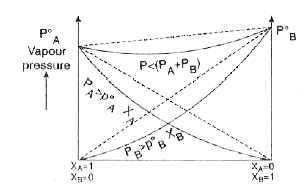What are ideal and non-ideal solutions ? What types of non-idealities are exhibited by cyclohexane-ethanol and acetone-chloroform mixtures ? Give reasons for your answer.
The solutions which obey Raoult.s law exactly at all concentrations and at all temperatures are called ideal solutions. According to Raoult.s law, the partial pressure of two components of the solutions are proportional to their mole fractions i.e.
PA=P∘A×xa
PB=P∘B×xB
where P∘A and P∘B are vapour pressures of two pure liquids, PA and PB are the partial vapour pressures of two components, and xaandxB are their mole fractions in solution. Therefore, for ideal solution, total pressure is
P=PA+PB=P∘A×xA+PB×xB
The characteristics of ideal solutions are :
(1) It must obey Raoult.s law
(ii)Δ H mixing should be zero
(iii)ΔV mixing should be zero.

The common examples of ideal solutions are benzene-toluene, n-hexane-n-heptane, ethyl bromide and ethyl iodide.
The variation of partial pressures of component A (PA)andB(PB) with their mole
fractions are shown in adjoining figure.
It is clear that
when xa=1,PA=P∘A×1=PA
when xB=0,PB=P∘B×0=0

(a) Cyclohexane-ethanol solution shows positive deviations from Raoult.s law. In these solutions, the alcohol molecules are held together by hydrogen bonding as shown below:

When cyclohexane is added to ethyl alcohol, the molecules of cyclohexane try to occupy the spaces between alcohol molecules. As a result, some hydrogen bonding in alcohol molecules break and the attractive forces become weak. As a result, the vapour pressure of the solution is slightly more on mixing.
The positive deviations have been shown in fig. In the figure, dotted lines show the ideal behaviour upon mixing while the thick lines show the actual behaviour.

(b) On the other hand, acetone-chloroform solutions show negative deviations from Raoult.s law as explained below:
When acetone and chloroform are mixed, there are new attractive forces due to intermolecular hydrogen bonding. As a result of new attractive forces, the escaping tendency of each liquid from solution becomes less.
Therefore, the vapour pressure of the solution is slightly less than what is expected from an ideal solution.
thus
PA<P∘A×xA
andPB<P∘B×xB
the total vapour pressure (PA+PB) becomes less than the corresponding vapour pressure expected from ideal solution । this is shown in fig
Topper's Solved these Questions
- SOLUTIONSBOOK - MBD -HARYANA BOARDCHAPTER - SOLUTIONSEXERCISE - SATQ (SHORT ANSWERS TYPE QUESTIONS )
16 Videos
- SOLID STATEBOOK - MBD -HARYANA BOARDCHAPTER - SOLID STATEEXERCISE - LONG ANSWER TYPE QUESTIONS
10 Videos
- SURFACE CHEMISTRYBOOK - MBD -HARYANA BOARDCHAPTER - SURFACE CHEMISTRYEXERCISE - LONG ANSWER TYPE QUESTIONS
4 Videos
Similar Questions
What are ideal and non-ideal solutions ? What type of non idealities are exhibited by cyclohexane-ethanol and acetone chloroform mixture ? Give reasons for your answer.
View SolutionWhat type of non-idealities are exhibited by cyclohexane-ethanol and acetone-chloroform mixture? Give reasons for your answer.
View SolutionRaoult’s Law, Ideal and Non ideal Solutions
View Solutionvapour pressure|ideal and non ideal solution
View SolutionWhat are ideal and non-ideal solutions ? Explain non-ideal solution showing positive deviations ?
View SolutionDistinguish between ideal and non-ideal solutions.
View SolutionWhat are the characteristics of a non-ideal solution
View SolutionRevision |Non-ideal Solutions
View SolutionBoiling point|Ideal and non ideal solutions and their properties
View SolutionWrite two differences between ideal solutions and non-ideal solutions.
View Solution
